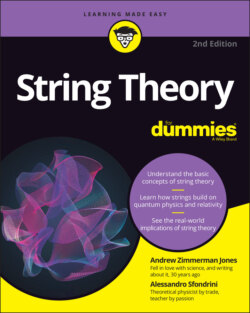Читать книгу String Theory For Dummies - Andrew Zimmerman Jones - Страница 26
Defining space and time
ОглавлениеIn many versions of string theory, the extra dimensions of space are compactified into a very tiny size, so they’re unobservable to our current technology. Trying to look at space smaller than this compactified size would provide results that don’t match our understanding of space-time. (As you see in Chapter 2, the behavior of space-time at these small scales is one of the reasons for a search for quantum gravity.) One of string theory’s major obstacles is attempting to figure out how space-time can emerge from the theory.
As a rule, though, string theory is built upon Einstein’s notion of space-time (see Chapter 6). Einstein’s theory has three space dimensions and one time dimension. String theory predicts a few more space dimensions but doesn’t change the fundamental rules of the game all that much, at least at low energies.
At present, it’s unclear whether string theory can make sense of the fundamental nature of space and time any more than Einstein did. In string theory, it’s almost as if the space and time dimensions of the universe are a backdrop to the interactions of strings, with no real meaning on their own.
Some proposals for how to address this have been developed, mainly focusing on space-time as an emergent phenomenon — that is, the space-time comes out of the sum total of all the string interactions in a way that hasn’t yet been completely worked out within the theory.
However, these approaches don’t meet some physicists’ bar for compelling scientific evidence, leading to criticism of the theory. String theory’s biggest competitor, loop quantum gravity, uses the quantization of space and time as the starting point of its own theory, as Chapter 19 explains. Some believe that this will ultimately be another approach to the same basic theory.
